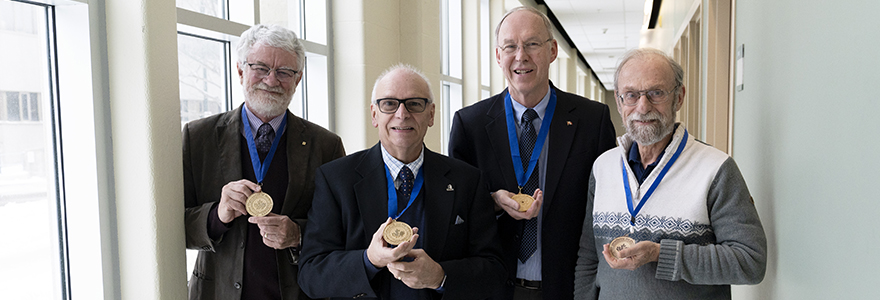A legacy of excellence in medical physics

By Ramtin Hakimjavadi, BMSc Candidate
As a group, they have transformed the practice of medical physics in Canada and beyond, influencing countless careers.For these contributions to the field, five members of the Department of Medical Biophysics at Schulich Medicine & Dentistry have received the Gold Medal from the Canadian Organization of Medical Physicists (COMP) – the late John C.F. MacDonald, PhD (2007), Aaron Fenster, PhD (2010), Jake Van Dyk, DSc (2011), Jerry Battista, PhD (2017) and Terry Peters, PhD (2019).
In Canada, this distinction is recognized as the highest honour attainable in the field. One COMP Gold Medalist at an institution is exemplary; five is truly exceptional.
A gold standard in training and mentorship
The late John C.F. MacDonald, PhD, was a pioneer of medical physics in Canada. During his career, he achieved many firsts in the field: he served as one of the first medical physicists in Ontario in 1951; he performed the dosimetry (the calibration and assessment of ionizing radiation dose) on the first cobalt therapy unit in the world to treat a patient with cancer; and 22 years after his retirement, he was the first researcher from Schulich Medicine & Dentistry to receive the COMP Gold Medal.A testament to MacDonald’s outstanding training and mentorship, two fellow winners – Battista and Van Dyk – are also former trainees of his, following in his footsteps to become leaders in the field.
Beyond teaching the knowledge and skills of the craft, MacDonald’s mentorship extended to how he carried himself as a clinical medical physicist. As a young student under MacDonald’s tutelage, Battista recalls one particular encounter, “I remember watching him kindly guide a wandering cancer patient. At that moment, I thought ‘this is what I want to do’.”
Leaders in education, advocates for the next generation
Professor Emeritus Jerry Battista, PhD, served as Chair of the Department of Medical Biophysics for 11 years, playing a significant role in establishing the educational infrastructure present today.
He actively pushed for accreditation from the Commission on Accreditation of Medical Physics Education Programs (CAMPEP). CAMPEP accreditation ensures that the quality of training is appropriate for physicists who will eventually work in a hospital or cancer centre. Students pursuing the MSc/PhD program in Medical Biophysics or the Residency Program in Clinical Physics based at the London Regional Cancer Program receive training that enables them to start their careers with key credentials and confidence.
Battista’s stewardship has contributed to a comprehensive education and training program at Schulich Medicine & Dentistry, one that can take undergraduate students pursuing medical physics and support them until they enter the workforce. "It is an incredible one-stop shop for education that I do not think can be found anywhere else in the world," he said.
In a career spanning 49 years, Professor Emeritus Jake Van Dyk’s devotion to clinical service was also unwavering. He worked on the implementation of radiation technology in the clinical practice of cancer treatment. As a scholar, Van Dyk, DSc, has written three volumes of the books entitled The Modern Technology of Radiation Oncology, several chapters of which Battista co-authored. He is presently working on volume 4, with an expected publication of June 2020.
Accelerating clinical translation for faster, safer therapies
Professor Aaron Fenster, PhD, leads a diverse team of medical imaging researchers at Robarts Research Institute. They have invented 3D-ultrasound technology that enhances image-guided diagnosis and minimally invasive therapies for carotid artery disease and various cancers.“Our goal is to develop image-guided technologies and make them more accessible in the clinical environment,” he said.
Serving as a testament to the global reach of his innovations, Fenster’s patents have been licensed to 13 companies, which have commercialized the technology for world-wide distribution.
Working just a few doors down from Fenster at Robarts, Professor Emeritus Terry Peters, PhD, leads the Virtual Augmentation and Simulation for Surgery and Therapy (VASST) Laboratory. His team develops image-guided tools for minimally invasive procedures in brain, cardiac and urological surgery. The technology allows surgeons to perform operations safer and faster than ever before, while seamlessly integrating with standard clinical procedures.
For Peters, who comes from a background in electrical engineering, an early project during his PhD studies introduced him to the world of medical physics. “I felt it was a perfect vehicle for translating physical science into devices that will ultimately have a positive effect on patients,” he said.
The key to this accelerated medical translation has been involving health care professionals early in the development process. "Physicians come and tell us about their biggest unmet clinical needs, and then we come up with an invention,” Fenster explained. “This really drives us to find solutions. We strive to improve health care, constantly trying to innovate ways to diagnose and treat patients.”
For Peters, his lab’s medical innovations would be unrealized if the tools could not easily integrate with the current standard of medical practice. “We start with the surgeon or the clinician at the grassroots level. That’s how our projects evolve,” he said. “It is important to make the user interface as intuitive to use as an app on a smartphone.”
A legacy of excellence at Western University
The stories and careers of Western’s five COMP Gold Medalists continue to inspire, representing a legacy of excellence in research, education and clinical service.“The gold medals are evidence that the quality of medical physics and imaging research at Western is really outstanding," said Fenster.








